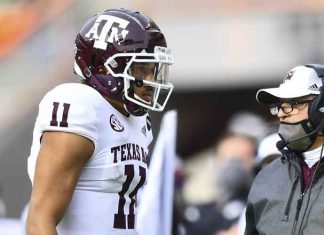ISLIP, N.Y. (AP) Nobody is keeping track of the score or exactly how much time is left in the game. Then again, the Colts and Cougars have been playing in the rain for about an hour and a coach still has to remind the official that a fumble is a dead ball.
It is not just the padded-up grade schoolers who are getting used to a new way to play football. The adults are learning, too.
”It’s bobbleheaded chaos out here,” a coach jokes as he helps line up the kids up for the final play.
Such is the nature of coaching 7-year-olds, but this condensed version of football, played on smaller fields with fewer players and coaches nearby directing the action, is an attempt to make things less chaotic. This is Rookie Tackle, a pilot program rolled out this year by USA Football that it is being offered by 10 youth sports organizations around the country, including this Police Athletic League in New York’s Suffolk County on Long Island.
Participation in youth sports has decreased over the last decade because of sports specialization, increased cost and shifts in population and demographics. Safety concerns, especially about concussions, compound the problem for football. Those involved with Rookie Tackle hope it can help draw more kids to football and keep them playing it as they grow up. Parents and local organizers say that by eliminating things like three-point stances, special teams and fumble recoveries, and emphasizing skill and technique development, Rookie Tackle can be a safer way to introduce football to younger players. USA Football, however, is focused on the developmental benefits.
”There’s really no way I can make it about safety,” said Scott Hallenbeck, executive director of USA Football. ”I don’t have any information that otherwise would say this form of football is safer than another form. So it’s not at all that we’re downplaying it. We sort of learned that’s a very, very challenging space. You need a lot of research. It takes a long time.”
For USA Football, Rookie Tackle fits in the middle of the model that starts with flag football and progresses to 11-on-11 the way baseball starts with T-ball, moves to coaches pitching to players and then to players pitching.
”Football is a sport that is one of the last sports not to have a true pathway model,” said former NFL quarterback Chad Pennington, who is a member of USA Football’s advisory board and the commissioner of the Kentucky Central Youth Football League that has incorporated Rookie Tackle this year.
Studies on the possible long-term effects and hazards of playing youth football have produced a range of inconclusive results, but there is no doubt that the increased attention on head injuries at all levels of the game has led some parents to steer children away from the sport. According to Aspen Institute data from the Sports & Fitness Industry Association, participation in tackle football is down 19 percent from 2011 to 2016. Broken down further, the drop is greater (25.6 percent) for ages 13-17 than ages 6-12 (6.4 percent).
Over the same period, participation in soccer, lacrosse, baseball and basketball for children ages 6-12 has dropped at an even greater rate than participation in football, according SFIA’s research.
Hallenbeck said participation numbers in tackle football have plateaued but USA Football is seeing an uptick in flag football being played at the youth levels. Pennington, who had an 11-year career with the Jets and Dolphins, has three sons, ages 13, 11 and 8.
”If they want to play tackle football, my personal conviction is they don’t start tackle football until the age of 10 or 11,” Pennington said. ”I really believe in the flag football game.”
Modified versions of football are nothing new. Six- and eight-man football on an 80-yard field has been played in sparsely populated areas at the youth and high school levels for decades. Rookie Tackle shrinks the game even more, following a path most sports have already embraced. Little League baseball uses pitching mounds that are 46 feet from home plate until players reach 13, and then they switch to the 60-feet, 6-inches used in professional leagues.
Youth hockey teams are encouraged to play the width of the ice instead of the length of a standard rink. Soccer scales the size of the pitch and the goals for different age groups. Tennis does the same with courts and rackets. So why have little kids playing football on the same fields as adults?
”If I was asked to play on a type of field that would correlate to a 9-year-old playing on a 100-yard field, then that means professionals should play on a 150-yard field by 75 yards wide,” Pennington said.
USA Football suggests Rookie Tackle fields be 40 yards to the end zone and 35 yards wide, with as few as six and as many as eight players to a side. Offense is played in only one direction, sort of like half-court basketball. All possessions start from the farthest yard-line away from the end zone. Less space and players leads to more activity on the field.
”In an 11-on-11 game you look at maybe the fastest kid runs the ball and maybe two chase and everyone else just stands and watches,” Pennington said. Blockers are eligible receivers in Rookie Tackle, and coaches are encouraged to rotate players from position to position.
Hallenbeck said USA Football is striving for uniformity with the rules but does not want to be rigid. In Islip, the Cougars and Colts were playing with eight players on the field and starting each possession from the 45-yard line. Every 15 yards was a first down.
Local organizers determine what age groups play rookie tackle. The Suffolk County PAL has 26 teams broken up into ages 5 and 6, 7 and 8. Anthony Williams, chairman of Suffolk County PAL football, said his plan is to run flag football leagues in the spring and Rookie Tackle in the fall.
Pennington’s league is offering Rookie Tackle to ages 8 and 9, and he said adding 10 and 11 next year is being considered.
The Philadelphia school district has started rookie tackle in its middle schools (ages 11 to 14) this year because it was down to five 11-on-11 football teams. Jimmy Lynch, executive director of athletics for the School District of Philadelphia, said a 14-team Rookie Tackle team launched the first week of October. For Lynch, the smaller playing field has the added benefit of allowing two games to be played on one standard 100-yard field in areas where facilities are limited. Lynch’s long-term goal is in line with the pathway USA Football is aiming to create: flag football in elementary school, Rookie Tackle in middle school and then 11-on-11 tackle on high school.
Unlike USA Football, Lynch and Williams don’t necessarily shy away from selling Rookie Tackle as a safer version of tackle football to parents.
”It’s a much safer version,” said Gregg Schwartz, whose son plays for the Colts. ”The kids are learning how to it. Learning how to get hit. Take tackles. Learning how to tackle the proper way, heads up. They’re learning basically everything they need to know to get them to the level where they need to get to in a year or two years from now.”
Chris Meyer, a football coach at William Floyd High School in Mastic Beach, New York, also has a son on the Colts. He said a scaled-down version of football is long overdue.
”I think it gets more kids involved in a controlled environment and where they’re not just bashing each other,” said Meyer, who played linebacker at Marist College in Poughkeepsie.
For now, USA Football is focused on Rookie Tackle as a way of addressing the long-term of health of the game itself.
”We really believe this game need to continue to evolve,” Hallenbeck said. ”How do you get more kids into the pipeline whether it be noncontact or contact related. And then, maybe as important if not more important, how do you make sure they have a positive experience because if they don’t have a positive experience they’re going to walk away.”
—
Follow Ralph D. Russo at www.Twitter.com/ralphDrussoAP
—
More college football coverage at http://collegefootball.ap.org and www.Twitter.com/AP-Top25
25% Bonus via Western Union

















